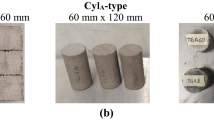Abstract
The present study was carried out to produce artificial hydraulic lime mortars for repair and conservation of historic masonry using a jarosite/alunite precipitate, a waste product of a novel Greek hydrometallurgical process developed to treat economically low grade nickel oxides ores. Alternative mortars were prepared by mixing lime powder, quartz sand and the above residue, substituting lime up to 50%. The mortars were prepared and tested according to European Norm EN 1015. They were cured for periods of 28 and 90 days and the compressive and flexural strengths were determined. The best mechanical behavior was observed for the mortar with 50% lime replacement, which also presented a low ratio of compressive to flexural strength (f c/f f). X-Ray diffraction, TG-DTA and mercury porosimetry were used to characterize the hydration products at 28 and 90 days. The results showed that the jarosite/alunite residue was dissolved in the high alkaline environment of the mortar, producing CaSO4 · 2H2O and AlOOH. During hydration, gypsum and some of the Ca(OH)2 were consumed, together with aluminum hydroxide in order to produce ettringite, a fact that improved the mechanical behavior of the produced mortars.







Similar content being viewed by others
References
Moropoulou A, Bakolas A, Aggelakopoulou E (2001) The effects of limestone characteristics and calcination temperature to the reactivity of quicklime. Cement Concr Res 31(4):633–639. doi:10.1016/S0008-8846(00)00490-7
Mosquera MJ, Silva B, Prieto B, Ruiz-Herrera E (2006) Addition of cement to lime-based mortars: effect on pore structure and vapor transport. Cement Concr Res 36(9):1635–1642. doi:10.1016/j.cemconres.2004.10.041
Moropoulou A, Bakolas A, Moundoulas P, Michailidis P (2000) Evaluation of compatibility between repair mortars and building materials in historic structures by the control of the microstructure of cement-based systems. Concr Sci Eng 2(8):191–195
Anagnostopoulos CA, Anagnostopoulos AC (2002) Polymer-cement mortars for repairing ancient masonries mechanical properties. Construct Build Mater 16(7):379–384. doi:10.1016/S0950-0618(02)00040-5
Moropoulou A, Bakolas A, Moundoulas P, Avdelidis NP (2000) Evaluation of compatibility between restoration mortars and traditional building materials by the control of the microstructure. In: Proc Conoscenze e Sviluppo di Criteri per la Definizione e Valutazione della Compatibilita nelle Malte per il Restauro, Scienza e Beni Culturali, Bressanone, pp 71–78
Rodriguez-Navarro C, Hansen E, Ginell WS (1998) Calcium hydroxide crystal evolution upon aging of lime putty. J Am Ceram Soc 81(11):3032–3034
Lanas J, Pérez Bernal JL, Bello MA, Alvarez JI (2006) Mechanical properties of masonry repair dolomitic lime-based mortars. Cement Concr Res 36(5):951–960. doi:10.1016/j.cemconres.2005.10.004
Moropoulou A, Bakolas A, Moundoulas P, Anagnostopoulou S, Aggelakopoulou E (2000) Compatible restoration mortars for the earthquake protection of Hagia Sophia. PACT, J Eur Study Group Phys Chem Biol Math Tech Appl Archaeol 59:29–51
Rota Rossi-Doria P (1998) Mortars for restoration: basic requirements and quality control. Mater Struct/Mater Constr 19(114):445–448
Moropoulou A, Cakmak AS, Biscontin G, Bakolas A, Zendri E (2002) Advanced Byzantine cement based composites resisting earthquake stresses: the crushed brick/lime mortars of Justinian’s Hagia Sophia. Construct Build Mater 16(8):543–552. doi:10.1016/S0950-0618(02)00005-3
Moropoulou A (2000) Reverse engineering to discover traditional technologies: a proper approach for compatible restoration mortars. PACT, J Eur Study Group Phys Chem Biol Math Tech Appl Archaeol 58:81–107
Hendry AW (2001) Masonry walls: materials and construction. Construct Build Mater 15(8):323–330. doi:10.1016/S0950-0618(01)00019-8
Degryse P, Elsen J, Waelkens M (2002) Study of ancient mortars from Salassos (Turkey) in view of their conservation. Cement Concr Res 32(9):1457–1563. doi:10.1016/S0008-8846(02)00807-4
Agatzini-Leonardou S, Dimaki D (1994) Recovery of nickel and cobalt from low-grade nickel oxide ores by heap leaching with dilute sulfuric acid at room temperature. Greek Patent No: 910100234
Agatzini-Leonardou S, Dimaki D (2001) Method for extraction of nickel and/or cobalt from nickel and/or cobalt oxide ores by heap leaching with a dilute sulfuric acid solution, prepared from sea water, at ambient temperature. Greek Patent No: 1003569
Agatzini-Leonardou S, Oustadakis P, Zafiratos J (2000) Removal of aluminum and chromium from nickel–cobalt sulfate solutions. Greek Patent No: 1003419
USEPA (1994) Method 1311: toxicity characteristic leaching procedure, test methods for evaluating solid wastes physical/chemical methods. United States Environmental Protection Agency
Moropoulou A, Bakolas A, Moundoulas P, Aggelakopoulou E, Anagnostopoulou S (2005) Strength development and lime reaction in mortars for repairing historic masonries. Cement Concr Compos 27(2):289–294. doi:10.1016/j.cemconcomp.2004.02.017
Sarp Tunçoku S, Emine Caner-Saltık N (2006) Opal-A rich additives used in ancient lime mortars. Cement Concr Res 36(10):1886–1893. doi:10.1016/j.cemconres.2006.06.012
EN 196-1 (1994) Methods of testing cement—determination of compressive strength
EN 1015 (1998–2002) Methods of test for mortar for masonry, parts 1–19
EN 1015-3 (1999) Methods of test for mortar for masonry—determination of consistence of fresh mortar (by flow table)
EN 1015-11 (1999) Methods of test for mortar masonry—determination of flexural and compressive strength of hardened mortar
Bakolas A, Aggelakopoulou E, Moropoulou A, Anagnostopoulou S (2006) Evaluation of pozzolanic activity and physico-mechanical characteristics in metakaolin-lime pastes. J Therm Anal Calorim 84(1):157–163. doi:10.1007/s10973-005-7262-y
Hampson CJ, Bailey JE (1982) On the structure of some precipitated calcium alumino-sulphate hydrates. J Mater Sci 17(11):3341–3346. doi:10.1007/BF01203504
Álvarez-Ayuso E, Nugteren HW (2005) Synthesis of ettringite: a way to deal with the acid wastewaters of aluminium anodising industry. Water Res 39(1):65–72. doi:10.1016/j.watres.2004.07.029
Pirard R, Alie C, Pirard JP (2002) Characterization of porous texture of hyperporous materials by mercury porosimetry using densification equation. Powder Technol 128(2–3):242–247. doi:10.1016/S0032-5910(02)00185-7
Author information
Authors and Affiliations
Corresponding author
Rights and permissions
About this article
Cite this article
Katsioti, M., Mauridou, O., Moropoulou, A. et al. Utilization of jarosite/alunite residue for mortars restoration production. Mater Struct 43, 167–177 (2010). https://doi.org/10.1617/s11527-009-9478-y
Received:
Accepted:
Published:
Issue Date:
DOI: https://doi.org/10.1617/s11527-009-9478-y




